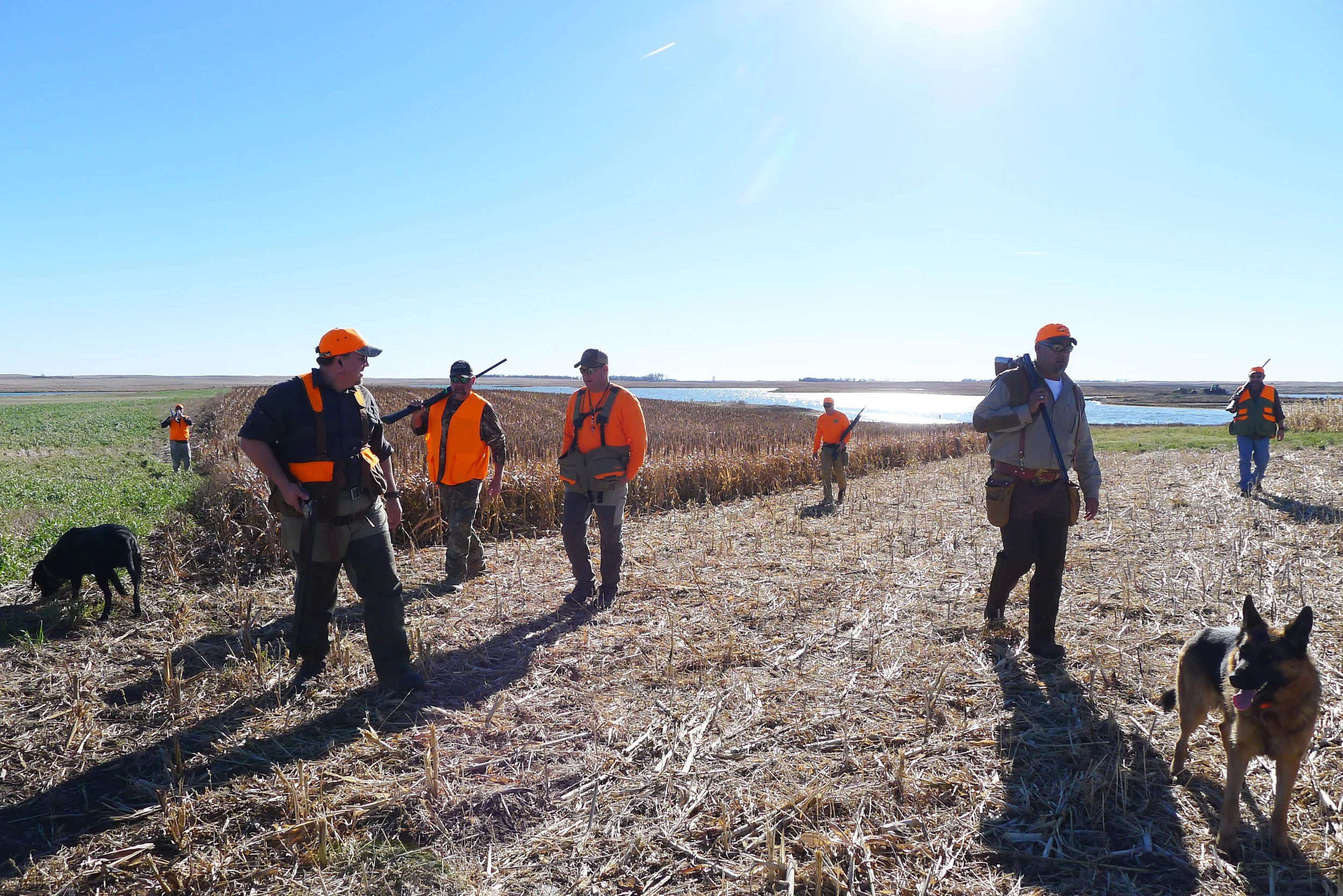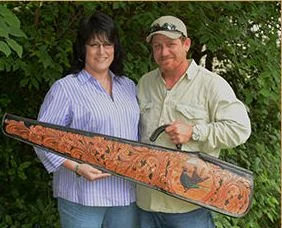Story by David Sefton
Photos by Leann Collins
Taking your wife bird hunting in Argentina can be especially fun. The romantic culture, centered around great wines, and fine dining set the backdrop for an extraordinarily luxurious hunting trip. Ours met our dreams in every regard. My wife enjoyed the ambiance, the wine cellar, and the lively active fun shooting. I loved the Cuban cigars, wine and of course unlimited shooting.
In the hustle and bustle of making a living: stepping back and enjoying one of life’s great experiences is important. For instance, imagine sitting in an olive grove, deep in the heart of ever romantic Argentina—the silver green leaves of the trees, rippling in the wind, deep blue sky. It’s beautiful and peaceful.
Suddenly, pigeons come blazing down the rows at warp speed. Standing to shoot, they start whipping up—down—sideways—corkscrews—then kamikaze dives—I miss yet again. Ah… but when you finally connect—it’s worth every miss; it’s heaven in the olive grove, with gun boys calling shots “left—right, left—right, high high, high.”
Nevertheless, the memories from the night’s evening meal stay with me. The great wine, incredible two-pound tenderloins, roasted to perfection over an open flame. Life is grand when you’re having fun in Córdoba, Argentina. You see, I am in heaven—truly heaven on earth. La Montaraz is a converted vineyard from the 1640s—now a lush luxury lodge in the heart of dove and pigeon country. After hunting doves many times in Argentina, I was looking for a truly unique experience, wild pigeons were calling. They’re faster, cagier, and far craftier than dove. The shooting is excellent, outstandingly excellent to be precise.
Our wonderful adventure started as most, a phone call to David Bodai of the Custom Sporting, he’s never let us down. He instinctively knows what we are looking for combining value, with excellence —in fact incredible hunting, over and over again. Our lodge, La Montaraz was spectacular, with exposed wood beams, an underground cellar full of racks and racks of aging wine—Saltillo tiled floors, rustic and luxurious at the same time. The owner, Tomas Frontera, has put together a wonderful operation. The grounds are immaculate, and Leo, our chef, beyond compare. Each meal was a gourmet feast and nothing, truly, I mean nothing was left undone. We had well decorated rooms, the most modern of lavatories, as well as maid service daily. We had choices; we could do nothing in luxury—or anything we wanted, including horseback riding with authentic gauchos.
Life turned at a leisurely richly textured pace—mixing high continental cuisine with wonderful local dishes and wines. The vineyard was in the process of developing a relatively unknown (in the United States) grape. One of the older varietals, typically used for blending, but being bottled as a stand-alone hearty wine—the Bonarda—a full, earthy, fruity blend that deep reads strongly carry. It was an amazing wine paired with a big full steak dinner, we enjoyed it immensely. Although the bottles are young, without labels, as they age in the cellar, I look forward to them coming on the market. The vineyard, of course, also produces Malbec. Leo the Magnificent, as I called him, even created a wonderful first course of appetizers made from the game we shot that day, surprisingly tasty.
This trip, I traveled with my own shotgun, a venerable Belgian Browning, over half a century old, a true workhorse, amazingly engraved in old style deep relief. Taking the gun into the country was surprisingly easy, although many had warned against. I wanted to be sure I could shoot with a comfortable gun. It was fun having my own shotgun and not relying on the house gun. I’m different from most writers and truly recommend carrying your own gun, because shotguns in Argentina take a pounding. With that said, the guns at La Montaraz were in excellent condition.
Pigeons offer an endlessly fascinating diversity of shots. They can be exceptionally challenging, “full choke” high, low and jinking, “skeet barrel” shot, or mid-range, (modified choke). As a right hand shooter my most comfortable shot was mid-high curving to the right. I could swing left to right, and get a good lead and drop these birds with probably 98% accuracy. Worst shot, was mid-low curving down right to left, I hit these probably less than 10%. A favorite shot I perfected was straight overhead, or overhead angling left to right. I could hit them amazingly high, probably 50—60 yards. I developed a trick shot, pick the bird up a foot or so (measured with reference to the gun barrel), follow from behind, passing over the bird; gun almost or straight up on the shoulder. As the barrel blocked out the view of the bird, firing but pausing the barrel—in other words, minimal follow through. Repeatedly, I knocked them out of the sky, it tickled the bird boy immensely, and he repeatedly cackled “muy lejos, muy lejos”. With that said, I could not get the hang of the low curving away shot, especially to the left side. Post game analysis: I think I was shooting over them; we are used to leading a bird to allow for ascent. These low curving descending shots need to be lead down more and ahead, closer to the ground than the pigeon. With the speed of the pigeon’s flight, straight head-on shots were challenging till you hit the groove. You actually need to shoot higher than the bird because of their incredible speed, thus creating a lead; sometimes you can’t see the bird for the barrel if it’s a head up rising shot. Few times in pigeon hunting are you presented with the traditional away shot, no need to practice, they’re traveling so fast, it’s a low percentage shot.
Pigeon hunting is about finding your groove and letting those birds outside your skill set pass. There are always more birds, no use shooting the 50-yard passing shots unless that’s your specialty. One trick I found is paying careful attention to the bird’s flight. If the bird is flying directly perpendicular to your shooting lane, it is far easier to hit, than if it is angling away, climbing AND perpendicular at distance. Adding three axes of movement to the lead really complicates the shot for the average shooter. Because the pigeons are so much larger than dove, and they have a relatively slow wing stroke, thus creating an optical illusion that they’re traveling slowly—nothing could be further from reality. Coasting, they’re traveling 32 to 45 miles per hour; when they turn on the afterburners, you might well be talking 55 miles per hour plus. As you get up over 50 mph, you’re really beginning to depend on luck for a strike rather than exemplary shooting skills.
Everyone always wonders how to best prepare. Five stand is the best preparation, more so than skeet, trap and a sporting clays course. You’re stationary in pigeon hunting as well as five stand. Don’t practice all the shots, for instance, you don’t have many if any “crazy teals”. The shots I think particularly useful to practice in order: the weak to strong mid-high angle pass shot; a high coming at you shot; a high overhead or close to it shot (not the straight up crazy teal); a strong to weak descending shot; straight at you any height; and finally a low crossing shot. If you get where you hit these consistently you are ready for Argentina. Most writers advise against taking your guns; it bears worth mentioning again, I’m just the reverse and advise, very strongly taking your best shooter (however not overly expensive). I personally enjoyed using my own 12-gauge, most advise 20-gauges; however pigeons are harder to bring down.
The limit is 150 pigeons per person per day, ample; I never felt the hunting was too slow. If the birds weren’t coming in, you went to another field. The single most important aspect of great pigeon hunting is great bird scouts. Our scouts were up every morning at 4 a.m. driving out to fields to check the pigeon’s flight paths. Pigeons are cagey and rarely feed in the same fields several days running. They’re constantly moving, and each morning the scouts tried to spot them. They radioed back to the lodge, and around 7:30 a.m. we would head for the fields. If the pigeons skipped our location, the scouts were working all day leading us to other fields. The roost was off limits, as we didn’t want to scare the pigeons out of the area. The wild pigeons were much more susceptible to hunting pressure than doves, they seem smarter and more easily figure out the game.
We hunted over top-of-the-line English decoys painted in exceptional life like detail. They’re similar to Mojos, except with a significantly extended arm that creates a realistic scene as the birds come in. When the pigeons flew close enough to realize the deception, they were off like miniature jets, thus creating some challenging shooting opportunities. Using my own shotgun facilitated accurate shooting and an enjoyable experience. Getting the gun into the country wasn’t as much a problem as many predicted.
Actually, the gun permitting process at the airport was a breeze. Take 100 one dollar bills for tips, spread them around liberally, and keep a twenty back to tip the gun agent. There is a hundred dollar tax per gun; however, all lodges charge around $50 a day to use their gun— you’re still ahead. Argentina is so much to many different people. For wives, it’s wonderful shopping in the leather district, it’s romantic sites, tango in the street, the open air flea markets, wine and wonderful national foods. For men, it’s great value, wonderful hunts and great steaks. When the hunt’s over, it’s sadly time to leave—because Argentina is more than a county, it’s a different place in time.
I hear the rhythm of the tango; I smell the clean crisp olive trees; I see the burgundy, deep burgundy, of their wines. More importantly, I see the beaming smile of the people, warm and exuberant, always ready to laugh. We made friends, dear friends, on this trip; we created life memories, we enjoyed the triple crown—great wingshooting, wonderful wine and fine food. From the crisp white jacketed valet handing us warm towels and cool drinks on arrival, to our wonderful new friends dropping us off at the airport as we reluctantly left— it was as close to heaven as I’ve found many years searching. La Montaraz is more than a lodge; it’s a lifestyle—old world luxury in modern ambiance. David, once again, a job well done.
Conservation Meets Hunting
We counted 32 olives in the craw of one pigeon from one feeding. Think about it, 32 times two to four feedings per day, times hundreds of thousands of pigeons; their destruction of the olive groves are devastating to a small farmer. Shooting pigeons may seem like just pure recreation, which it can be, but it’s a lot more to Argentines trying to make a living off the land. American hunters provide an important source of income to the small farmer and do him a service by keeping these agricultural pests in check. The pigeon hunter has replaced mass poisoning of the past years saving millions of song birds, hawks and eagles. It’s an incredible partnership that works to balance agriculture needs with wildlife. The poisoning wiped out all bird species and other wildlife, not just the pigeons.
--DAVID SEFTON.
© 2016 David Sefton



































